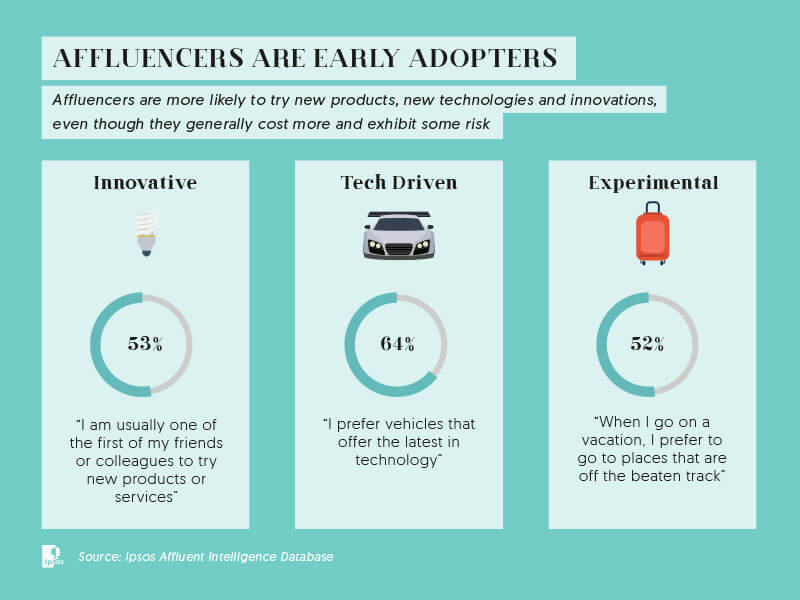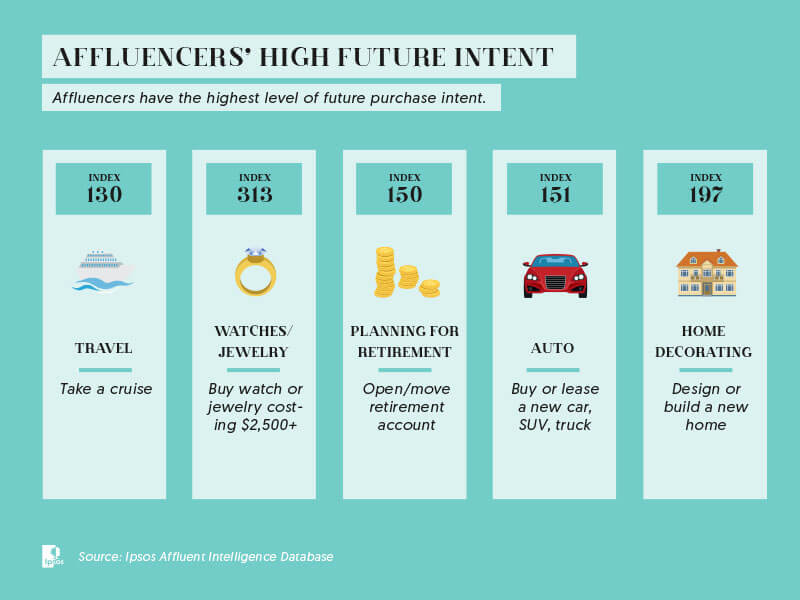The influence of affluence: How to leverage the ‘Affluencers’
Meet the "Affluencers." Columnist Peter Minnium explains why marketers should be paying attention to a powerful target group who are heavy spenders, early adopters and major influencers.
 If you subscribe to even a handful of marketing and advertising publications and blogs, you’ve no doubt been seeing a lot of articles, listicles, how-tos and case studies lately about influencer marketing. That’s because influencer marketing is the fastest-growing online marketing channel — faster than paid search, affiliate marketing and even display advertising. There are many factors in how we’ve gotten here.
If you subscribe to even a handful of marketing and advertising publications and blogs, you’ve no doubt been seeing a lot of articles, listicles, how-tos and case studies lately about influencer marketing. That’s because influencer marketing is the fastest-growing online marketing channel — faster than paid search, affiliate marketing and even display advertising. There are many factors in how we’ve gotten here.
In search of influencers
First, there’s the well-documented fragmentation of media and the decline of the traditional mass media outlets. Reaching consumers has never been more complex, complicated and challenging. And it’s not getting any easier.
There’s also the rise of digital audience buying and the commensurate emergence of the myriad transparency and quality issues with regard to the media supply chain. Programmatic has made it easy to buy tens of millions of impressions while making it difficult to know if any of these impressions actually reach a real person. Estimates of bots, ad fraud and unviewable ads range from 50 to 75 percent of all inventory. What’s a marketer to do?
Brands have tended to respond to these challenges with ever more invasive and intrusive digital ads. This has, in turn, led to another key factor: the resultant rise in ad-blocker software. Estimates are that over 40 percent of desktop users and 15 percent of mobile users have installed ad blocking software. So even reaching engaged digital readers has become problematic.
Which brings me back to influencers. Spreading your brand’s message far and wide through traditional mass media is a greater challenge than ever. So the idea of reaching a more targeted group of people who are particularly powerful and influential, and who can further mobilize and spread your brand’s message, is a hotter concept than Atlanta in July.
Naturally, marketers are jumping on board. A 2016 eMarketer study showed that of all marketers who have already used influencer marketing, nearly half said they intend to increase their spending and focus on this marketing tactic this year.
Meet the ‘Affluencers’
Forbes contributor Kyle Wong defined influencer marketing as “a form of marketing that identifies and targets individuals who have influence over potential buyers.” And one of the most influential target groups has always been the affluent market. Those households with income over $125,000 represent just 16 percent of all US households, but their net worth is 68 percent of total US net worth, according to our company’s research. And their spending across all industries and categories is on average 2.6 times that of non-affluents.

In addition, it’s been well-documented that when a product or service is seen or associated with the affluent market, it tends to drive interest down through and among the mass market — since so many aspire to live a more upscale lifestyle, thus making them doubly influential.
Michael Baer, head of Ipsos (my employer) Affluent Intelligence Group, says they have identified an even more powerful, concentrated group of affluents who have a disproportionate influence with their networks and across each and every category. He calls them “Affluencers.”
These folks are not just powerful based on the money they have and spend — although our research shows they have 6 percent higher net worth and spend another 40 percent more than “mere” affluents — they also are influencers who influence others and their adoption of brands, categories and new products.
Affluencers seek new experiences and new products, and they tend to be early adopters of emerging innovation, technology and services.

Over half of them say they are usually the first of their friends to try new products and services. A majority of them prefer the latest technology in the categories they shop. And they tend to seek new experiences, from entertainment to travel to hobbies. This early adoption naturally influences their peer group and network to also try new things — and trickles down through a broader demographic.

In addition, these folks have significantly higher future purchase intent in all categories than the broader affluent group. From taking a cruise to buying an auto to designing or buying a new home to purchasing jewelry costing $2,500+, Affluencers tend to be in-market more often — which makes them more conversant and current on nearly every category, and more valuable to marketers.

Importantly, they are looked on as experts, influencers and leaders whose advice is sought in at least one category — with 50 percent of all affluencers being influencers in five or more categories, according to our research. And nearly all of them (97 percent) acknowledge that others seek them out for their advice. These are people whom brands need to understand, find, engage with and provide the incentive and the content to share with their networks.
Influencing the Affluencers
While demographically and geographically similar to general affluents, Affluencers, and even more so “Ultra-Affluencers” (who claim influence over more than five categories), tend to be younger than average affluents. They also have higher household incomes and net worth than the broader affluent target — in fact, Ultra-Affluencers have an average household income nearly $80,000 more than that of the broad group, our research shows.
Where they really differentiate is in media consumption and usage. Affluencers of all stripes read more, watch more, visit more websites and open more mobile apps than standard affluents. For example, Affluencers/Ultra-Affluencers index at 119/150 for Heavy Website usage, vs. general affluents; 118/157 for Heavy Publication (print and website) usage; and 113/128 for Heavy TV viewership.
In addition, as you might expect, they are heavier users of social media, with Affluencers averaging nearly three more hours per week than general affluents. These are people who need to stay up to date — and then feel compelled to share their thoughts.
Finally, and perhaps most importantly, Affluencers spend more in every category than the already heavy-spending general affluent audience. While 33 percent of affluents report as “heavy spenders” in general, 40 percent of Affluencers do so (with 55 percent Ultra-Affluencers doing so).
In addition, Affluencers are particularly heavy spenders in the categories they influence. For example, Automotive Affluencers spend 5.3x that of non-affluents, Alcoholic Beverages Affluencers spend 6.6x, and Personal Insurance Affluencers spend at a rate of 9.7x. It is self-evident that these folks drive their categories — and are critical to understand and to engage with.
There is no doubt that influencers will continue to have a powerful and enduring role in the media and marketing world’s new normal — which is why marketers need to take heed of the Affluencer, a combination heavy spender, early adopter, high intender and major influencer. Figuring out how to access their power should be at least one page in every marketer’s marketing plan.
Opinions expressed in this article are those of the guest author and not necessarily MarTech. Staff authors are listed here.
Related stories
